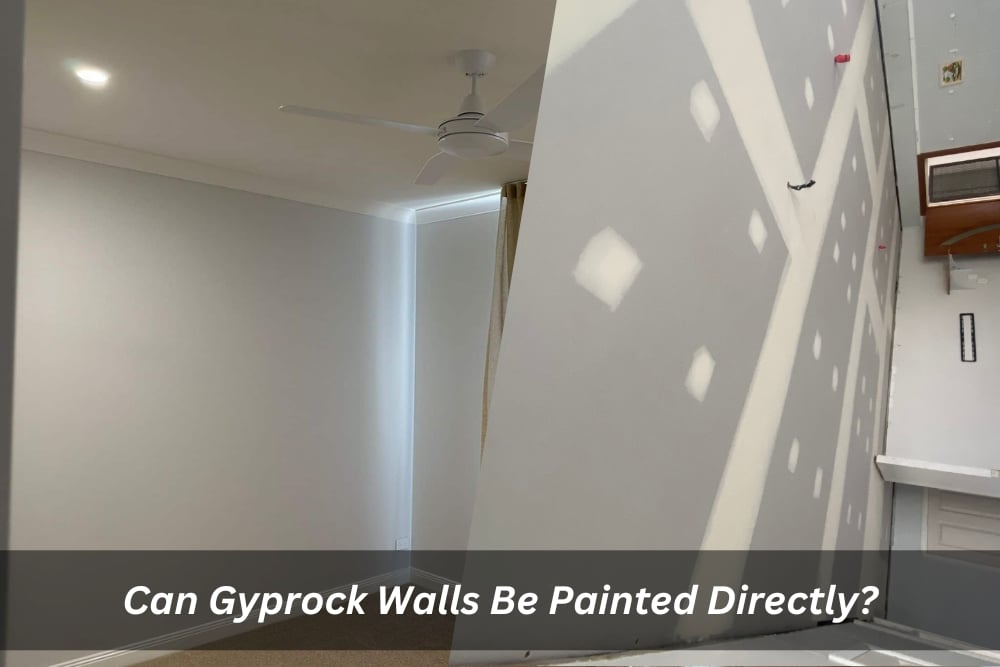Embarking on a painting gyprock project can be an exciting and rewarding way to transform your living space. But if you’re facing brand new gyprock walls, you might wonder: can you skip the prep work and paint gyprock directly, or is there more involved?
The answer is simple: yes, you can paint gyprock directly. However, skipping proper preparation before painting gyprock can lead to a less-than-ideal finish down the line. Here’s a comprehensive guide to painting gyprock, ensuring a smooth, flawless look that lasts.
Should you paint gyprock directly?
Gyprock, also known as plasterboard, is a versatile building material used for walls and ceilings. It has a paper facing that provides a good base for paint – but only if it’s properly prepared. Here’s why skipping prep work for painting gyprock isn’t recommended:
- Uneven paint absorption: Raw gyprock is quite absorbent. Paint applied directly will soak unevenly, resulting in a patchy finish. Some areas might appear blotchy and require additional coats, while others might appear starved for paint.
- Poor paint adhesion: Without proper priming, the paint might not adhere well to the gyprock surface. This can lead to peeling, flaking, and cracking over time, requiring repainting sooner rather than later.
By taking the time to prime your gyprock before painting, you ensure a uniform finish, better paint adhesion, and ultimately, a more professional-looking result.
How to prepare gyprock for painting: A step-by-step guide
Now that you understand the importance of prep work, let’s dive into the steps involved in preparing gyprock for painting.
Tools and Materials:
- Drop cloths
- Sandpaper (fine grit)
- Dust mask
- Safety glasses
- Putty knife
- Joint compound (if necessary)
- Primer suitable for gyprock (consult a paint professional for recommendations)
- Paint roller with extension pole (optional)
- Paintbrush
Step 1: Cleaning the gyprock surface
Before you start priming, ensure the gyprock surface is clean and free of dust, dirt, and cobwebs. Use a damp cloth to wipe down the walls, then allow them to dry completely.
Tip: Wear a dust mask and safety glasses for protection while cleaning.
- Addressing minor imperfections:
If you notice any minor surface imperfections like screw holes or gouges, use a putty knife to apply a thin layer of joint compound. Once dry, sand the area smooth with fine-grit sandpaper.
Step 2: Applying primer to gyprock
Priming is the key step that transforms the raw gyprock surface into an ideal canvas for painting. Here’s what you need to know:
- Choosing the right primer:
Opt for a primer specifically designed for use on gyprock. These primers often have a slightly textured finish that helps the paint adhere better.
- Applying the primer:
- Stir the primer thoroughly before use.
- Pour some primer into a paint tray.
- Use a paintbrush to cut in along edges, corners, and around fixtures.
- Use a paint roller with an extension pole for a faster and more even application on larger surfaces.
- Apply a thin, even coat of primer and allow it to dry completely (refer to the drying time on the primer label).
- Once dry, sand the primer lightly with fine-grit sandpaper to remove any bumps or imperfections.
Tip: Apply a second coat of primer for extra coverage, especially if the gyprock is particularly absorbent.
Choosing the right paint for painting gyprock
Now that your gyprock is primed and ready, it’s time to choose the perfect paint! Here are some things to keep in mind:
Paint type:
- Opt for latex paint, also known as water-based paint, for painting gyprock. It’s easy to use, dries quickly, and offers good coverage.
- Avoid oil-based paints, as they can be more challenging to work with and require specific solvents for cleanup.
Paint color and finish:
- Consider the room’s function and lighting when choosing a paint color. Warmer colors can make a small room feel more inviting, while cooler colors can create a sense of spaciousness.
- The paint finish also plays a role. Flat finishes are great for hiding minor imperfections but might not be as washable. Satin or eggshell finishes offer a good balance between washability and a slight sheen. Gloss finishes are highly durable and easy to clean but can highlight imperfections.
Tips and tricks for a flawless painting job on Gyprock
Here are some handy tips to ensure a professional-looking finish when painting gyprock:
- Use drop cloths: Protect your floors and furniture from paint splatters with drop cloths.
- Cut in carefully: Use a brush for clean lines around edges, corners, and trim. Take your time and ensure a neat application to avoid having to touch up later.
- Maintain a wet edge: When rolling, work in sections and maintain a wet edge to prevent visible roller marks. Overlap slightly as you move across the wall.
- Apply thin coats: For optimal coverage and a beautiful, smooth finish, apply two thin coats of paint. Resist the urge to use a thick coat, as it can drip and take much longer to dry.
- Allow proper drying time: Let each coat of paint dry completely before applying the next. Rushing the process can lead to peeling or cracking later.
- Clean up as you go: Regularly wipe drips and splatters with a damp cloth while the paint is still wet. This will save you time and effort cleaning up later.
Can you paint over the existing paint on gyprock?
So you have existing paint on your gyprock walls, and you’re itching for a fresh look. The good news is, that painting over existing paint on gyprock is often possible. However, there’s a crucial step involved: assessing the condition of the existing paint.
- Inspect the existing paint: Look for signs of peeling, flaking, or cracking. If the paint is in good condition, lightly sand it with fine-grit sandpaper to create a better surface for the new paint to adhere to.
- Clean the surface: Wipe down the walls with a damp cloth to remove any dust or dirt.
- Prime, if necessary: If the existing paint is glossy or a dramatically different color from your new choice, applying a primer before painting can ensure better coverage and a more even finish.
Conclusion
Painting gyprock walls can be a straightforward and rewarding DIY project. By following these steps and taking the time for proper preparation, you can achieve a beautiful, long-lasting finish that transforms your space. Remember, proper priming is key to ensure a smooth, even application of paint and prevent future issues.
If you’re tackling a gyprocking or painting project in Brisbane, the Djari Group can be your one-stop solution! Our team of experienced professionals offers a range of services, from gyprock installation and plastering to professional painting.
Contact us today for a free quote and discuss your project. We’ll work closely with you to understand your vision and ensure a seamless and successful project. Let us help you create a beautiful and lasting transformation in your home!



